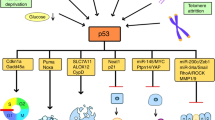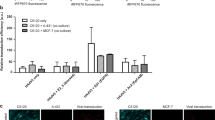Abstract
Current clinical success rates of adenoviral vector (Adv)–based gene therapy of squamous cell carcinoma (SCC) of the head and neck remain unsatisfactory. A major problem with this approach is thought to be related to low Adv transduction efficiency due to weak expression of the adenovirus receptor, coxsackie–adenovirus receptor (CAR), in SCC. To improve the limited infectivity of Adv in oral SCC, we constructed mutated Adv incorporating the integrin-binding motif, RGD, in the HI loop of the fiber knob. The mutated Adv infected target cells through integrins commonly expressed in oral SCC. LacZ marker gene expression after infection with this mutated Adv (Adv-F/RGD) in oral SCC cell lines that showed reduced expression of CAR was approximately 5–10 times higher than that obtained with the parental Adv containing wild-type fiber knob (Adv-F/wt). In an in vitro study, transduction of oral cancer cell lines with Adv-F/RGD expressing human IL-2 (AxCAhIL2-F/RGD) resulted in greater production of cytokine than AxCAhIL2-F/wt infection. In an in vivo therapeutic xenograft model of oral SCC in nude mice, AxCAhIL2-F/RGD demonstrated antitumor effects superior to those of AxCAhIL2-F/wt. These data suggest that exploitation of genetically altered adenovirus vectors with integrin-binding motifs may offer significant improvements in oral SCC gene therapy.
This is a preview of subscription content, access via your institution
Access options
Subscribe to this journal
Receive 12 print issues and online access
$259.00 per year
only $21.58 per issue
Buy this article
- Purchase on Springer Link
- Instant access to full article PDF
Prices may be subject to local taxes which are calculated during checkout






Similar content being viewed by others
References
Vokes EE, Weichselbaum RR & Lippman SM, et al. Head and neck cancer. N Engl J Med. 1993; 328: 184–194.
Larson DL, Lindberg RD & Lane E, et al. Major complications of radiotherapy in cancer of the oral cavity and oropharynx. A 10 year retrospective study. Am J Surg. 1983; 146: 531–536.
Ervin TJ, Clark JR & Weichselbaum RR, et al. An analysis of induction and adjuvant chemotherapy in the multidisciplinary treatment of squamous-cell carcinoma of the head and neck. J Clin Oncol. 1987; 5: 10–20.
O'Malley BW Jr, Chen SH & Schwartz MR, et al. Adenovirus-mediated gene therapy for human head and neck squamous cell cancer in a nude mouse model. Cancer Res. 1995; 55: 1080–1085.
Goebel EA, Davidson BL & Zabner J, et al. Adenovirus-mediated gene therapy for head and neck squamous cell carcinomas. Ann Otol Rhinol Laryngol. 1996; 105: 562–567.
Clayman GL, el-Naggar AK & Roth JA, et al. In vivo molecular therapy with p53 adenovirus for microscopic residual head and neck squamous carcinoma. Cancer Res. 1995; 55: 1–6.
O'Malley BW, Cope KA & Chen SH, et al. Combination gene therapy for oral cancer in a murine model. Cancer Res. 1996; 56: 1737–1741.
Wilson KM, Stambrook PJ & Bi WL, et al. HSV-tk gene therapy in head and neck squamous cell carcinoma. Enhancement by the local and distant bystander effect. Arch Otolaryngol Head Neck Surg. 1996; 122: 746–749.
Liu TJ, el-Naggar AK & McDonnell TJ, et al. Apoptosis induction mediated by wild-type p53 adenoviral gene transfer in squamous cell carcinoma of the head and neck. Cancer Res. 1995; 55: 3117–3122.
Clayman GL, el-Naggar AK & Lippman SM, et al. Adenovirus-mediated p53 gene transfer in patients with advanced recurrent head and neck squamous cell carcinoma. J Clin Oncol. 1998; 16: 2221–2232.
Clayman GL, Frank DK & Bruso PA, et al. Adenovirus-mediated wild-type p53 gene transfer as a surgical adjuvant in advanced head and neck cancers. Clin Cancer Res. 1999; 5: 1715–1722.
Rocco JW, Li D & Liggett WH Jr et al. p16INK4A adenovirus-mediated gene therapy for human head and neck squamous cell cancer. Clin Cancer Res. 1998; 4: 1697–1704.
Sewell DA, Li D & Duan L, et al. Optimizing suicide gene therapy for head and neck cancer. Laryngoscope. 1997; 107: 1490–1495.
Bergelson JM, Krithivas A & Celi L, et al. The murine CAR homolog is a receptor for coxsackie B viruses and adenoviruses. J Virol. 1998; 72: 415–419.
Miller CR, Buchsbaum DJ & Reynolds PN, et al. Differential susceptibility of primary and established human glioma cells to adenovirus infection: targeting via the epidermal growth factor receptor achieves fiber receptor–independent gene transfer. Cancer Res. 1998; 58: 5738–5748.
Kasono K, Blackwell JL & Douglas JT, et al. Selective gene delivery to head and neck cancer cells via an integrin targeted adenoviral vector. Clin Cancer Res. 1999; 5: 2571–2579.
Li D, Duan L & Freimuth P, et al. Variability of adenovirus receptor density influences gene transfer efficiency and therapeutic response in head and neck cancer. Clin Cancer Res. 1999; 5: 4175–4181.
Bergelson JM, Cunningham JA & Droguett G, et al. Isolation of a common receptor for Coxsackie B viruses and adenoviruses 2 and 5. Science. 1997; 275: 1320–1323.
Tomko RP, Xu R & Philipson L . HCAR and MCAR: the human and mouse cellular receptors for subgroup C adenoviruses and group B coxsackieviruses. Proc Natl Acad Sci USA. 1997; 94: 3352–3356.
Pasqualini R, Koivunen E & Ruoslahti E . Alpha v integrins as receptors for tumor targeting by circulating ligands. Nat Biotechnol. 1997; 15: 542–546.
Wickham TJ, Tzeng E & Shears LL II, et al. Increased in vitro and in vivo gene transfer by adenovirus vectors containing chimeric fiber proteins. J Virol. 1997; 71: 8221–8229.
Dmitriev I, Krasnykh V & Miller CR, et al. An adenovirus vector with genetically modified fibers demonstrates expanded tropism via utilization of a coxsackievirus and adenovirus receptor–independent cell entry mechanism. J Virol. 1998; 72: 9706–9713.
Krasnykh V, Dmitriev I & Mikheeva G, et al. Characterization of an adenovirus vector containing a heterologous peptide epitope in the HI loop of the fiber knob. J Virol. 1998; 72: 1844–1852.
Yoshida Y, Sadata A & Zhang W, et al. Generation of fiber-mutant recombinant adenoviruses for gene therapy of malignant glioma. Hum Gene Ther. 1998; 9: 2503–2515.
Miyake S, Makimura M & Kanegae Y, et al. Efficient generation of recombinant adenoviruses using adenovirus DNA–terminal protein complex and a cosmid bearing the full-length virus genome. Proc Natl Acad Sci USA. 1996; 93: 1320–1324.
Maizel JV Jr, White DO & Scharff MD . The polypeptides of adenovirus: I. Evidence for multiple protein components in the virion and a comparison of types 2, 7A, and 12. Virology. 1968; 36: 115–125.
Nyberg-Hoffman C, Shabram P & Li W, et al. Sensitivity and reproducibility in adenoviral infectious titer determination. Nat Med. 1997; 3: 808–811.
Nakamura Y, Wakimoto H & Abe J, et al. Adoptive immunotherapy with murine tumor–specific T lymphocytes engineered to secrete interleukin 2. Cancer Res. 1994; 54: 5757–5760.
Belin MT & Boulanger P . Involvement of cellular adhesion sequences in the attachment of adenovirus to the HeLa cell surface. J Gen Virol. 1993; 74: 1485–1497, Part 8
Wickham TJ, Mathias P & Cheresh DA, et al. Integrins alpha v beta 3 and alpha v beta 5 promote adenovirus internalization but not virus attachment. Cell. 1993; 73: 309–319.
Ruoslahti E . RGD and other recognition sequences for integrins. Annu Rev Cell Dev Biol. 1996; 12: 697–715.
Hynes RO, Schwarzbauer JE & Tamkun JW . Isolation and analysis of cDNA and genomic clones of fibronectin and its receptor. Methods Enzymol. 1987; 144: 447–463.
Chen SH, Shine HD & Goodman JC, et al. Gene therapy for brain tumors: regression of experimental gliomas by adenovirus-mediated gene transfer in vivo. Proc Natl Acad Sci USA. 1994; 91: 3054–3057.
Bagutti C, Speight PM & Watt FM . Comparison of integrin, cadherin, and catenin expression in squamous cell carcinomas of the oral cavity. J Pathol. 1998; 186: 8–16.
Thomas GJ, Jones J & Speight PM . Integrins and oral cancer. Oral Oncol. 1997; 33: 381–388.
Nagashima S, Reichert TE & Kashii Y, et al. In vitro and in vivo characteristics of human squamous cell carcinoma of the head and neck cells engineered to secrete interleukin-2. Cancer Gene Ther. 1997; 4: 366–376.
Gropp R, Frye M & Wagner TO, et al. Epithelial defensins impair adenoviral infection: implication for adenovirus-mediated gene therapy. Hum Gene Ther. 1999; 10: 957–964.
Grill J, Van Beusechem VW & Van Der Valk P, et al. Combined targeting of adenoviruses to integrins and epidermal growth factor receptors increases gene transfer into primary glioma cells and spheroids. Clin Cancer Res. 2001; 7: 641–650.
Ganly I, Kirn D & Eckhardt G, et al. A phase I study of Onyx-015, an E1B attenuated adenovirus, administered intratumorally to patients with recurrent head and neck cancer. Clin Cancer Res. 2000; 6: 798–806.
Lamont JP, Nemunaitis J & Kuhn JA, et al. A prospective phase II trial of ONYX-015 adenovirus and chemotherapy in recurrent squamous cell carcinoma of the head and neck (the Baylor experience). Ann Surg Oncol. 2000; 7: 588–592.
Nemunaitis J, Ganly I & Khuri F, et al. Selective replication and oncolysis in p53 mutant tumors with ONYX-015, an E1B-55 kD gene–deleted adenovirus, in patients with advanced head and neck cancer: a phase II trial. Cancer Res. 2000; 60: 6359–6366.
Nemunaitis J, Cunningham C & Buchanan A, et al. Intravenous infusion of a replication-selective adenovirus (ONYX-015) in cancer patients: safety, feasibility and biological activity. Gene Ther. 2001; 8: 746–759.
Suzuki K, Fueyo J & Krasnykh V, et al. A conditionally replicative adenovirus with enhanced infectivity shows improved oncolytic potency. Clin Cancer Res. 2001; 7: 120–126.
Acknowledgements
This work was supported, in part, by Grants from the Ministry and Education, Culture, and Science of Japan, the Ministry of Health and Welfare of Japan, the Naito Foundation, and the Shionogi Foundation.
Author information
Authors and Affiliations
Rights and permissions
About this article
Cite this article
Dehari, H., Ito, Y., Nakamura, T. et al. Enhanced antitumor effect of RGD fiber-modified adenovirus for gene therapy of oral cancer. Cancer Gene Ther 10, 75–85 (2003). https://doi.org/10.1038/sj.cgt.7700529
Received:
Published:
Issue Date:
DOI: https://doi.org/10.1038/sj.cgt.7700529
Keywords
This article is cited by
-
Cytotoxic effects of replication-competent adenoviruses on human esophageal carcinoma are enhanced by forced p53 expression
BMC Cancer (2015)
-
Survivin-responsive conditionally replicating adenovirus kills rhabdomyosarcoma stem cells more efficiently than their progeny
Journal of Translational Medicine (2014)
-
Antitumor effect of genetically engineered mesenchymal stem cells in a rat glioma model
Gene Therapy (2004)



